Drilling & Completion Technology
High-performance fracture fluid outperforms conventional fluids
A West Texas field operator has applied a new viscoelastic frac fluid that provides viscosity for proppant carrying without need for breakers. Case history comparing offset well shows promising production increases
Lynn Palmore and David McKenzie, Halliburton; and Randall Foster, Triumph Exploration
A High-Performance Fracturing Fluid (HPF) has led to a step change in the completion process of the San-Andres reservoir in Andrews County, Texas. Recent development in fluid technology has resulted in the introduction of a unique, patented fracturing fluid, the Halliburton MicroPolymer (HMP), that is: less damaging to the formation, has excellent proppant transportability and requires no breakers. Despite very robust and stable rheological properties during pumping, the new HPF returns to its original viscosity shortly after closure, with no internal breakers. The unique properties of this fluid are discussed herein, along with case history information.
Additionally, the article will attempt to explain well performance compared to wells in the same field that were fractured with conventional, low-polymer loading borates. The distinctive properties of this fluid are presented, along with a discussion of the retained fracture conductivity. A case history application shows better return on investment using this new fluid.
INTRODUCTION
The field of interest is the Means San-Andres field in Andrews County, about 10 miles northwest of Andrews, Texas. The San-Andres reservoir is an oil-producing dolomite ranging from about 4,600 to 4,700 ft with average porosity and permeability of 10% and 0.05 to 0.5 mD, respectively, and a bottomhole static temperature (BHST) of 105°F. The drive mechanism of the San-Andres is a weak water drive and gas expansion of undersaturated oil.
Fracture stimulation of the San-Andres has evolved from pumping inefficient oil-based fluids, which provided poor proppant-transport properties, to using borate-crosslinked polymer systems, which are considered to have efficient leakoff control and excellent proppant-transport properties. For several years, a low-polymer borate system has been used. The typical job size consists of 70,000 gal of a low-polymer borate fluid carrying 140,000 lb of 16/30-mesh white sand pumped down 5.5-in. casing with an average rate of 35 bpm and a maximum sand concentration of 6 lb/gal. This job design was the result of several step changes that evolved from attempts to optimize the frac design and place a higher proppant concentration in the fracture. Average production rates in the San-Andres range from 40 to 60 bopd, plus 250 bwpd, with a fairly rapid decline.
CHANGE IN PROCESS
With the application of new viscoelastic fluid technology, a robust HPF has been developed that can dramatically reduce the detrimental conductivity-damaging properties of conventional polymer-based fluids. HMP has polymer-like fluid rheology and fluid-loss control even though no high-molecular-weight polymer chains are present. Additionally, it can delink back to its initial low viscosity without chemical breakers.
Short molecular units that can link/delink create a transitory pseudopolymer, Fig. 1. These pseudopolymer chains can further link to build a fluid with a high level of 3D stability, Fig. 2. The transitory nature of the chain allows the fluid to behave like a polymer, but chemicals are not required to break the polymer chain. The strength of the crosslink is determined by base fluid pH and the specific metal ion used as a crosslinking agent. The natural pH of the formation is sufficient to delink the frac fluid; therefore, when the job is complete and pumping has stopped, it will delink back to the short molecular units, allowing for efficient clean-up and minimal damage to the proppant bed.
 |
Fig. 1. A transient pseudopolymer can be formed under correct environmental conditions by linking short molecular units. This example exhibits rheology and fluid-loss properties similar to common guar-based polymers. This reaction is easily reversible to the starting short-molecular units by controlling pH.
|
|
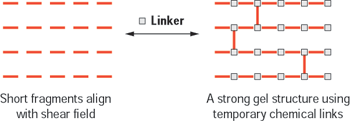 |
Fig. 2. In a shear field, the short molecular fragments quickly align with the field. Affecting the linking reaction in this shear regime leads to a highly organized, 3D network that has a high level of elasticity. Because of the dynamic nature of the linking reaction, this structure continuously reorganizes to adjust to the shear field.
|
|
Fluid properties of the HMP system are so robust that fluid design changes, such as reduced pad volumes, lower rates and increased sand concentrations, can be incorporated into the frac design. The San-Andres was considered a prime candidate for fracturing with the HPF because of its robust fluid properties and ability to delink and clean up with minimal damage to the formation and proppant bed. The selected wells had produced sufficiently with the existing frac design using a low-polymer borate system; but changing to the new system was considered feasible because it could potentially increase proppant concentration in the fracture and increase fracture conductivity by minimizing damage incurred from the frac fluid.
FRACTURE CONDUCTIVITY, FLUID LOSS
Damage to fracture conductivity from gel filter cake and unbroken gel has been a persistent industry problem. Attempts to alleviate the damage have included using very aggressive breaker systems, gel filter-cake removal procedures, and new chemical systems developed to improve or enhance frac fluid performance. HMP has been tested with proppant packs at reservoir conditions to determine fracture conductivity.
All fluid systems used for hydraulic fracturing affect proppant pack conductivity. Comparison of the reduction in the conductivity to that of the proppant pack with no fluid present is the fluid system index. Specifically, this index is the value (expressed as a decimal fraction) determined by dividing proppant-pack conductivity – including effects of the fluid system – by the baseline conductivity of the dry proppant bed. Conductivity values and corresponding fluid system index values for the new system with no breakers added are shown in Table 1. The same data for a conventional low-polymer borate system with a typical oxidizing breaker is also presented.
| |
Table 1. API cell conductivity values |
|
| |
Closure stress, psi
|
Conductivity, mD-ft
|
Fluid system index
|
|
| |
Fluid A with 2 lb/ft2 20/40-mesh Ottawa sand |
|
| |
2,000 |
2,744 |
0.65 |
|
| |
4,000 |
1,705 |
0.74 |
|
| |
6,000 |
540 |
0.62 |
|
| |
Fluid B with oxidizing breaker at 180°F with 2 lb/ft2 20/40-mesh Ottawa sand |
|
| |
2,000 |
674 |
0.16 |
|
| |
4,000 |
390 |
0.17 |
|
| |
6,000 |
209 |
0.24 |
|
| |
Fluid C with highly activated oxidizing breaker at 180°F, with 2 lb/ft2 20/40 sand |
|
| |
2,000 |
2,526 |
0.60 |
|
| |
4,000 |
1,011 |
0.44 |
|
| |
6,000 |
488 |
0.56 |
|
|
The table further shows data for a conventional, low-polymer borate system with a highly aggressive breaker package, including an oxidizing breaker and a catalyst. The aggressive breaker package system shows improved performance over the conventional breaker package, but performance of the HMP system is not dependent on breakers. Aggressive breaker systems used with a crosslinked polymer gel can help remove gel filter cake and help break the gel, but the residue created from breaking the crosslinked polymer can cause considerable damage to the fracture conductivity.
When the HMP delinks and reverts back to short-chain molecules, the fluid can flow back through the proppant bed with minimal damage to fracture conductivity. As a result, the system provides an increased effective propped length compared to that of low-polymer borate systems, which translates into improved production. Fig. 3 compares a low-polymer borate system broken with an enzyme breaker and the new system delinked by dropping the pH.
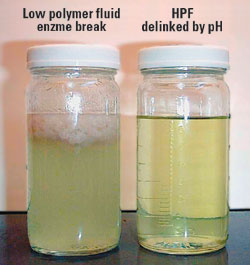 |
Fig. 3. Broken fluid comparison.
|
|
For fluid loss, lab testing shows that, through development of gel filter cake, the new system is very efficient. Table 2 compares fluid-loss coefficients for HMP and conventional low-polymer borate systems. Fig. 4 shows dynamic fluid-loss curves for three permeability core samples. The comparison illustrates that the new system can provide fluid-loss coefficients comparable to conventional fluid systems, indicating that the HMP system does not compromise the fluid efficiency of a fracturing treatment. The system is highly efficient and does not begin to delink until pumping has stopped and positive pressure from leakoff has dissipated.
| |
Table 2. Dynamic fluid-loss coefficients, HPF at 180°F with Ohio sandstone core wafers (0.1 to 0.3 mD) |
|
| |
Fluid |
Cw, ft/min0.5 |
Spurt, gas/ft2 |
|
|
|
|
| |
Fluid A: HPF system11 cP at room temperature |
0.0019 |
0.003 |
|
| |
Fluid B: Conventional fluid 25 lb/Mgal with 0.25-lb breaker (guar/borate with oxidizing breaker) |
0.0029 |
0 |
|
| |
Fluid C: Conventional fluid 25 lb/Mgal with 15-lb high activity catalyzed breaker package (guar/borate, with activated oxidizing breaker) |
0.0036 |
0.003 |
|
|
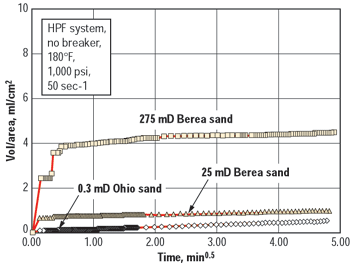 |
Fig. 4. HPF dynamic fluid-loss comparison.
|
|
CASE HISTORY
Two wells were chosen for comparison of HMP to conventional low-polymer borate systems: 1) a newly drilled completion to be fracture stimulated with HMP, and 2) a direct offset well previously stimulated using the conventional low-polymer borate system. Fig. 5 shows location of the comparison wells. The wells are similar. The low-polymer borate well (No. 1) has an elevation of 3,189 ft, 9% average porosity, 27.1% water saturation, and 134.5-ft total net pay. The HMP well (No. 2) has 3,193-ft elevation, 9% average porosity, 32.1% water saturation, and 85.5-ft total net pay.
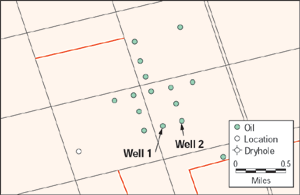 |
Fig. 5. Comparison of well locations in Andrews County, Texas. Well 1 is the low-polymer borate system; Well 2 is the HPF system.
|
|
The frac design of Well 1 consisted of 70,000 gal of low-polymer borate carrying 143,000 bbl of 16/30-mesh white sand pumped at 35 bpm with a maximum sand concentration of 6 lb/gal. The job was pumped to completion with 2,200-psi average treating pressure. With the conventional low-polymer borate fluids being used, pad volumes had been increased up to about 40% in an attempt to place more and higher concentrations of proppant in the formation. Generally, a maximum concentration of 6 lb/gal was achieved with the low-polymer borate fluid and, often, the well was on the verge of screening out at the end of the scheduled treatment.
The frac design of Well 2 consisted of 30,500 gal of HMP carrying 143,000 lb of 16/30-mesh white sand pumped at 35 bpm, with a maximum sand concentration of 10 lb/gal. Total fluid volume was reduced by 50%, pad volume was reduced to 33%, and sand concentration was increased to 10 lb/gal. With these changes, the frac treatment using the HMP system was pumped at an average 2,700 psi with no problems. The surface treating pressure increased because friction properties of the HMP system are higher than those of the low-polymer borate.
Fig. 6 shows production data from both wells. The initial rate of Well 2 was a little higher than that of Well 1, with a significant difference in production decline. After 30 days, Well 2 had a fairly sustained production rate of 170 bopd, whereas Well 1 continued to decline. Well 2 started to decline after 100 days of production, but continued to produce at a considerably higher rate than Well 1.
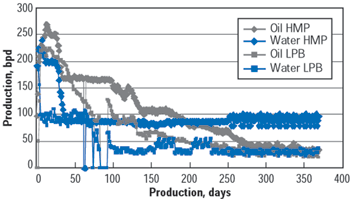 |
Fig. 6. Production rate comparison.
|
|
A cumulative production revenue comparison of the two wells is shown in Fig. 7. Well 2 had a cumulative production of 38,700 bbl oil, compared to 26,400 bbl for Well 1. This difference is equivalent to a created value increase of over $189,000 for the HMP-fraced well, based on $18/bbl oil.
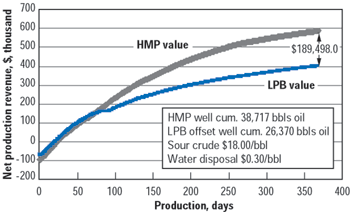 |
Fig. 7. Cumulative net production revenue comparison.
|
|
CONCLUSIONS
Application of an advanced viscoelastic fracturing fluid resulted in a positive impact on production of the San-Andres formation in Andrews County, Texas. The highly robust fluid properties of the HMP system enabled a more-aggressive proppant schedule to be successfully placed in the well with no problems. The increased sand concentration placed in the proppant pack, along with the clean nature of the delinked fluid and the short molecular units of the base fluid, allow for higher fracture conductivity, which directly correlates to a longer effective propped frac length. The fracture conductivity and effective propped length led to a production increase in the HMP-fractured well. Since this study was performed, the pump rates have been reduced even further to 15 – 18 bpm.
Note: This article was prepared from the paper of the same name written by the same authors and presented at the 50th annual Southwestern Petroleum Short Course, April 16 – 17, 2003, sponsored by Texas Tech University, Lubbock, Texas. 
BIBLIOGRAPHY
McGowen, J. M. and S. Vitthal, “Fracturing-fluid leakoff under dynamic conditions, Part 1: Development of a realistic laboratory testing procedure,” Paper SPE 36492, presented at the 1996 SPE Annual Technical Conference and Exhibition, Denver, Colorado, October 6 – 9.
Parker, M. A. and B. W. McDaniel, “ Fracturing treatment design improved by conductivity measurements under in-situ conditions,” Paper SPE 16901, presented at the 1987 Annual Technical Conference and Exhibition, Dallas, Texas, September 27 – 30.
Voneiff, G. W., B. M. Robinson and S. A. Holditch, “The effects of unbroken fracture fluid on gas well performance,” Paper SPE 26664, presented at the 1993 SPE Annual Technical Conference and Exhibition, Houston, Texas, October 3 – 6.
Weaver, J., et al., “Application of new viscoelastic fluid technology results in enhanced fracture productivity,” Paper SPE 71662, presented at the 2001 SPE Annual Technical Conference and Exhibition, New Orleans, Louisiana, September 30 – October 3.
THE AUTHORS
|
 |
Lynn Palmore is a senior account representative in Halliburton’s Business Development Group in Midland, Texas. He has 25 years with Halliburton. He is a graduate of the honorary University of Hard Knocks, sponsored by Alderson-Broaddus College, Philippi, West Virginia. He has spent the majority of his career in the oil fields of West Texas. He is a member of AADE, and SPE. Mr. Palmore is the product champion for Halliburton MicroPolymer fracture fluid in the Permian basin. He can be reached at lynn.palmore @halliburton.com.
|
 |
David McKenzie is a technical specialist for Halliburton Energy Services in Midland, Texas. He has 21 years with Halliburton, working various areas of the Permian basin. He holds a BSCE from Texas Tech University and is a member of SPE.
|
 |
Randall Foster is president of Triumph Exploration, Inc., a Midland, Texas, based oil and gas producer and active exploration company. He has 30 years’ experience in the oil and gas industry He received a bachelor of arts degree from the honorary University of Hard Knocks, sponsored by Alderson-Broaddus College, Philippi, West Virginia. He is a member of SPE, Permian Basin Petroleum Association, New Mexico Oil and Gas Association and AADE.
|
|












